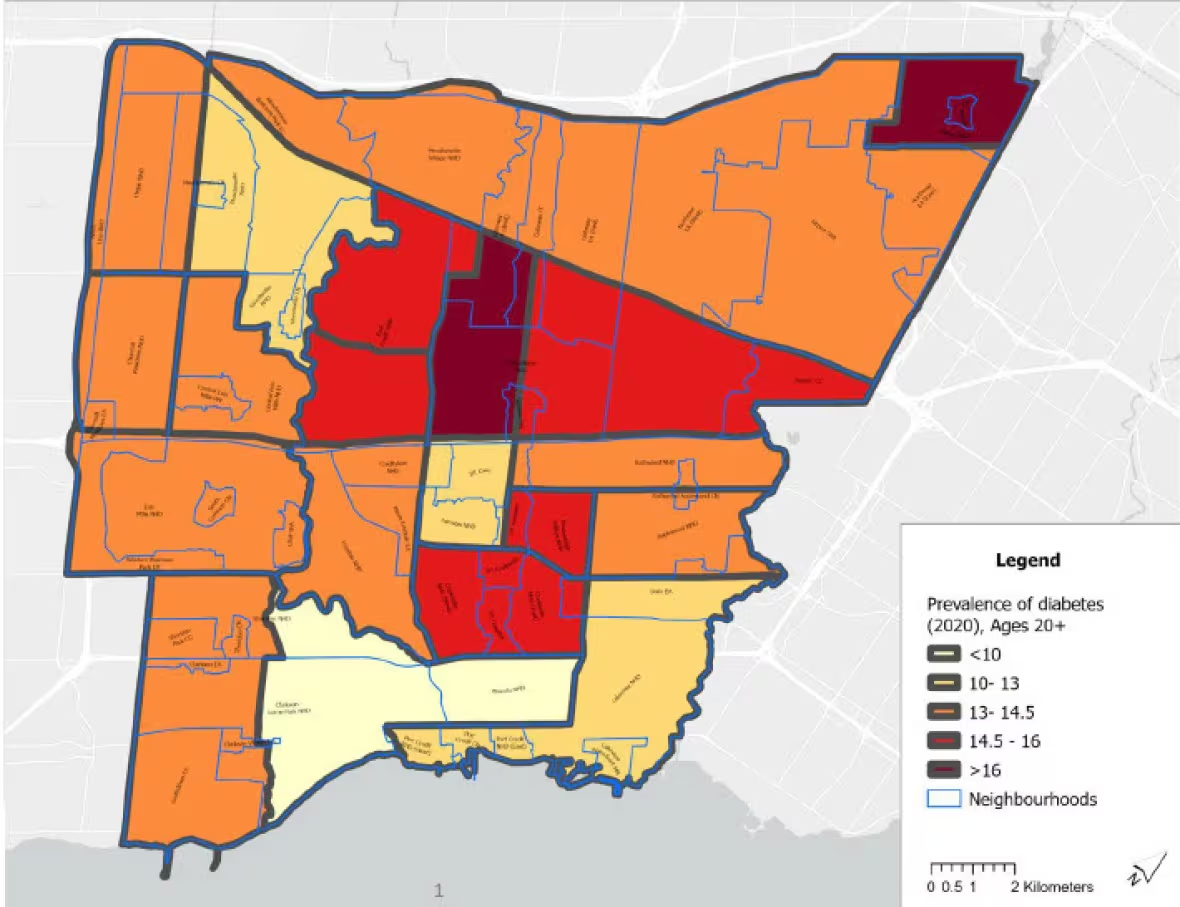Mississauga is facing an 'unprecedented' diabetes problem — and green space could be part of the solution
Research shows diabetes prevalence as high as 16.9% in parts of city, compared to Ontario average of 9.8%

Mississauga is facing an "unprecedented" rate of diabetes higher than the provincial average, a researcher says, and part of the solution could be green spaces and places to walk.
Research from the Novo Nordisk Network for Healthy Populations, a diabetes research group based at the University of Toronto working collaboratively with community and governments, paints a worrisome picture about diabetes prevalence rates in Peel region. Novo Nordisk, which provided a donation to the university, makes the diabetes drug Ozempic.
According to the data, for most neighbourhoods in Mississauga, diabetes prevalence rates range from 13 to 16.9 per cent of the city's population. The Ontario average rate among adults is 9.8 per cent of the population, the research shows.
Ghazal Fazli, an epidemiologist with the University of Toronto, one of the entities that make up the research group, says the problem has been building for far too long.
"It's unprecedented," she said. "That trend is not going to stop. That trend is on the rise in the region in the years to come."
She says diabetes rates in many neighbourhoods in Mississauga are up to two thirds higher than the provincial average.
It's a problem so acute that the city of Mississauga is now working on a diabetes strategy that includes healthcare partners, researchers and community. Fazli says the research group is working closely with the city to explore why rates are higher in certain areas, providing the city with data and ideas and looking for possible solutions.
Green space and activity options matter: researcher
Type 2 diabetes occurs when the pancreas does not produce enough insulin or when the body does not adequately use the insulin produced. Some of the risk factors for diabetes include having a higher body weight, poor diet, and activity levels.
Certain ethnic groups, including South Asians, which make up a significant portion of Mississauga's population, are at an increased risk of Type 2 diabetes and are often diagnosed with the disease earlier in life than some other groups, according to Fazli.

Fazli says genetic predisposition to diabetes can be amplified by the environments in which people live. It can be difficult to form healthy habits to ward off diabetes in neighbourhoods that have less green space, are not walkable, have less access to healthy food options or include many households where people are working multiple jobs or under stress, she says.
Using diagnoses data derived from the Institute for Clinical Evaluative Sciences, a provincially-funded body with access to administrative health data records, the Novo Nordisk Network for Healthy Populations team parsed the numbers by postal code. It found some neighbourhoods do in fact have an increased prevalence of diabetes.
A map shared as part of a report presented at a Mississauga committee meeting on Feb. 20 showed pockets identified within Mississauga with higher rates of the disease. One area where diabetes is particularly prevalent is near the centre of the map of the city, to the west of Hurontario Street, south of Gateway and part of West Uptown. Diabetes rates are also particularly high in the furthest northeast corner of the city.

Fazli says some of the risk factors for the disease can be lessened by changes to the environments around us and says the city can play a role in creating more paths for active transportation or ensuring recreation spaces are plentiful.
"These are risk factors that can be modified through policy interventions," Fazli said, adding the strategy must also be about "meeting people where they are at" and thinking about other barriers people may have to exercising or eating well.
Ultimately, it will be the city that decides what the strategy will look like, she says.
Diabetes prevalence uneven throughout city
The city has been actively working on the problem during the pandemic, says Rob Trewartha, director of strategic communications and initiatives with the city of Mississauga. Later this year, staff will return to council with a draft strategy for tackling diabetes.
And while it's too soon to say what the recommendations might be, municipal interventions could include looking at things like the way a neighbourhood is built, increasing active transportation opportunities, creating community gardens or looking closely at recreation programs available in certain hot spots, Trewartha says. Certain programs could also be targeted toward certain communities within Mississauga, he adds.
"How your city is designed, has a big impact on chronic diseases and your health," he said.

Trewartha says council's support for the work so far indicates the city remains willing to look at the factors causing the discrepancies and to do its part.
"We know we have a challenge on our hands," said Trewartha. "We also know that that's not evenly distributed across the entire city."
The city already held a well-attended event about creating a diabetes strategy in November 2023 as part of its Healthy City Expo. Fazli says community involvement like this will be essential in ensuring whatever strategies and programs the city and its partners decide to act on will be a success.
Improving outcomes will require not only collaboration with the researchers, community and health partners, but also with other levels of government, Trewartha added.
"Mississauga cannot tackle diabetes by ourselves," he said.